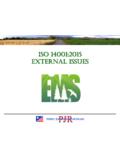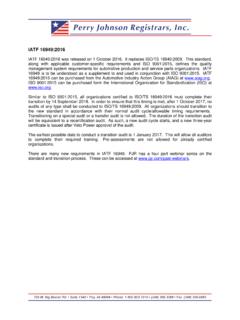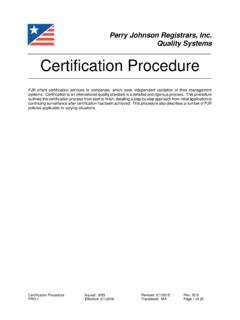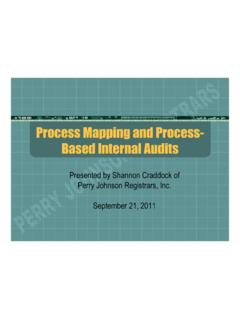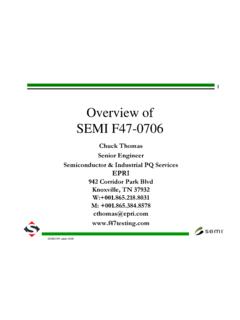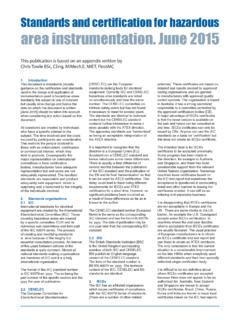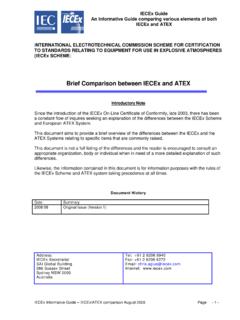Transcription of ISO/IEC 17021-1:2015 IMPACT ON THE CERTIFIED CLIENT
1 PRESENTED BY SHANNON CRADDOCK, PROGRAMS & ACCREDITATIONS MANAGER ISO/IEC 17021-1:2015 IMPACT ON THE CERTIFIED CLIENT TODAY S APPROACH What is ISO/IEC 17021-1:2015 ? Review ISO/IEC 17021-1:2015 clauses that IMPACT CERTIFIED clients and applicants. Remember that sector-specific rules supersede these requirements. ISO/IEC 17021-1:2015 Requirements for bodies (certification bodies or registrars) providing audit and certification of management systems. This is the ISO standard for companies such as PJR. PJR began conforming to the requirements on 11 April 2016. Our conformity will be assessed in upcoming 2016 audits. CLAUSE Where a CLIENT has received management systems consultancy from a body that has a relationship with a certification body, this is a significant threat to impartiality. A recognized mitigation of this threat is that the certification body shall not certify the management system for a minimum of two years following the end of consultancy.
2 CLAUSE The certification body shall maintain (through publications, electronic media or other means), and make public, without request, in all geographical areas in which is operates, information about A) audit processes; B) processes for granting, refusing, maintaining of certification, extending or reducing the scope of certification, renewing, suspending or restoring, or withdrawing of certification; C) types of management systems in which it operates; D) the use of the CB s name and certification mark or logo; E) processes for handling complaints and appeals; F) policy on impartiality. CLAUSE The certification body shall provide upon request information about; A) geographical areas in which it operates; B) the status of a given certification; C) the name, normative relative document, scope and geographical location (city and country) for a specific CERTIFIED CLIENT ; CLAUSE The certification document(s) shall identify the following: B) the effective date of granting, expanding or reducing the scope of certification, or renewing certification which shall not be before the date of the relevant certification decision; NOTE: The certification body can keep the original certification date on the certificate when a certificate lapses for a period of time provided that The current certificate cycle (3 years) start and expiry date are clearly indicated.
3 The last certification cycle expiry date be indicated along with the date of recertification audit. CLAUSE A certification body shall have rules governing any management system certification mark that it authorizes CERTIFIED clients to use. These rules shall ensure, among other things, traceability back to the certification body. There shall be no ambiguity, in the mark or accompanying text, as to what has been CERTIFIED and which certification body has granted the certification. The mark shall not be used on product nor product packaging nor in any other way that may be interpreted as denoting product conformity. CLAUSE A certification body shall not permit its marks to be applied by CERTIFIED clients to laboratory test, calibration or inspection reports or certificates. CLAUSE A certification body shall have rules governing the use of any statement on product packaging or in accompanying information that the CERTIFIED CLIENT has a CERTIFIED management system.
4 Product packaging is considered as that which can be removed without the product disintegrating or being damaged. Accompanying information is considered as separately available or easily detachable. Type labels or identification plates are considered as part of the product. The statement shall in no way imply that the product, process or service is CERTIFIED by this means. The statement shall include reference to: Identification ( brand or name) of the CERTIFIED CLIENT ; The type of management system ( quality, environment) and the applicable standard; and The certification body issuing the certificate. CLAUSE The certification body shall require an authorized representative of the applicant organization to provide the necessary information to enable it to establish the following: B) details of the applicant organization including its name and the address(es) of its site(s), its processes and operations, human and technical resources, functions, relationships and any relevant legal CLAUSE Surveillance audits shall be conducted at least once a calendar year except in re-assessment years.
5 The date of the first surveillance audit following initial certification shall not be more than 12 months from the certification decision date. NOTE: It can be necessary to adjust the periodicity of surveillance audits to accommodate factors such as seasons or management systems certification of a limited duration ( temporary construction site). CLAUSE Where the certification body is taking account of certification already granted to the CLIENT and to audits performed by another certification body, it shall obtain and retain sufficient evidence, such as reports and documentation on corrective actions, to any nonconformity. The documentation shall support the fulfilling of the requirement in the part of ISO/IEC 17021. The certification body shall, based on this information obtained, justify and record any adjustments to the existing audit program and follow up the implementation of corrective actions concerning previous nonconformities.
6 CLAUSE The audit objectives shall describe what is to be accomplished by the audit and shall include the following: B) determination of the ability of the management system to ensure the CLIENT meets applicable statutory, regulatory and contractual requirements; C) determination of the effectiveness of the management system to ensure the CLIENT can reasonably expect to achieve it specified objectives; CLAUSE The audit plan shall be appropriate to the objectives and scope of the audit. The audit plan shall at least include or refer to the following: F) the roles and responsibilities of the audit team members and accompanying persons, such as observers and interpreters. CLAUSE The tasks given to the audit team shall be defined, and require the audit team to D) communicate to the CLIENT , for its action, any inconsistencies between the CLIENT s policy, objectives and targets. A nonconformity will be written if inconsistencies exist.
7 CLAUSE Planning shall ensure that the objectives of stage 1 can be met and the CLIENT shall be informed of any on site activities during stage 1. NOTE: The stage 1 does not require a formal audit plan. CLAUSE The objectives of the stage 1 are to C) ensure the organization has identified internal and external issues and problems ( risks and opportunities) D) obtain necessary information regarding the scope of the management system including Locations of the CLIENT Processes and equipment used Levels of controls established (particularly in the case of multisite clients ) Applicable statutory and regulatory requirements and the status to conform to compliance obligations. CLAUSE In determining the interval between stage 1 and stage 2, consideration shall be given to the needs of the CLIENT to resolve areas of concern identified during the stage 1. The certification body may also need to revise its arrangements for stage 2.
8 If any significant changes which would IMPACT the management system occur, the certification body shall consider the need to repeat all or part of the stage 1. The CLIENT shall be informed that the results of the stage 1 may lead to postponement or cancellation of the stage 2. CLAUSE The purpose of the stage 2 is to evaluate the implementation, including effectiveness, of the CLIENT s management system. The stage 2 shall take place at the site(s) of the CLIENT . It shall include the auditing of at least the following: C) the CLIENT s management system ability and its performance regarding meeting of applicable statutory, regulatory and contractual requirements. CLAUSE Where any part of the audit is made by electronic means or where the site to be audited is virtual, the certification body shall ensure that activities are conducted by personnel with appropriate competence. The evidence obtained during such an audit shall be sufficient to enable the auditor to take an informed decision on conformity of the requirement in question.
9 NOTE: On-site audits can include remote access to electronic site(s) that contain(s) information that is relevant to the audit of the management system. CLAUSE A formal opening meeting, shall be held with the CLIENT s The degree of detail shall be consistent with the familiarity of the CLIENT with the audit The requirement to record the attendance of those attending the opening meeting has been removed. CLAUSE Under the responsibility of the audit team leader and prior to the closing meeting, the audit team D) confirm the appropriateness of the audit program or identify any modification required for future audits ( scope of certification, audit time or dates, surveillance frequency, audit team competence). CLAUSE AND O The audit team leader shall ensure that the audit report is prepared and shall be responsible for its content. The audit report shall provide an accurate, concise and clear record of the audit to enable an informed certification decision to be made and shall include or refer to the following: H) any significant issues impacting on the audit program O) a disclaimer statement indicating that auditing is based on a sampling process of the available CLAUSE The audit report shall also contain A) a statement on the conformity and the effectiveness of the management system together with a summary of the evidence relating to: The capability of the management system to meet applicable requirements and expected outcomes; The internal audit and management review process B) a conclusion on the appropriateness of the certification scope.
10 C) confirmation that the audit objectives have been fulfilled. CLAUSE The certification body shall have a process to conduct an effective review prior to making a decision for granting certification, expanding or reducing the scope of certification, renewing, suspending or restoring, or withdrawing of certification, including, that B) for any major nonconformities, it has reviewed, accepted and verified the correction and corrective actions; C) for any minor nonconformities it has reviewed and accepted the CLIENT s plan for correction and corrective action. CLAUSE If the certification body is not able to verify the implementation of corrections and corrective actions of any major nonconformity within 6 months of the last day of the stage 2, the certification body shall conduct another stage 2 prior to recommending certification. CLAUSE The certification body shall maintain certification based on demonstration that the CLIENT continues to satisfy the requirements of the management system standard.
